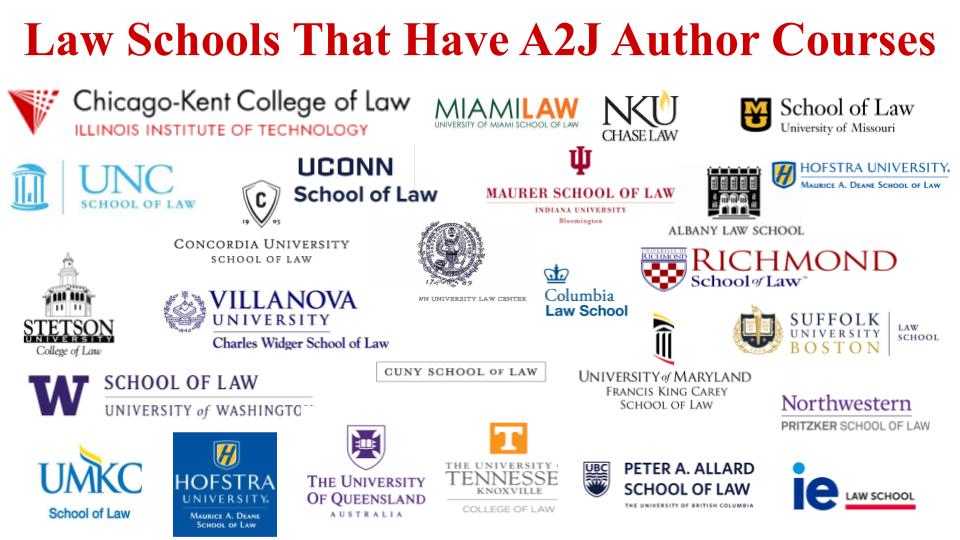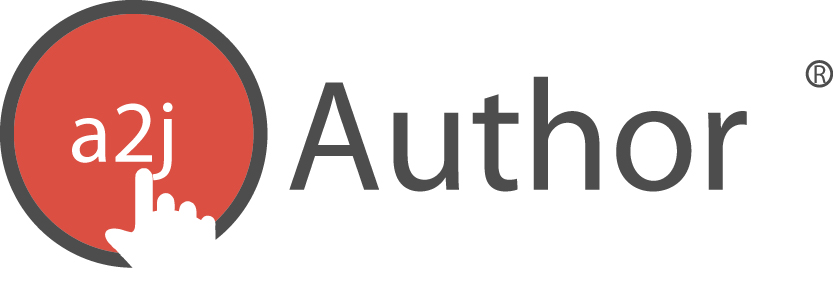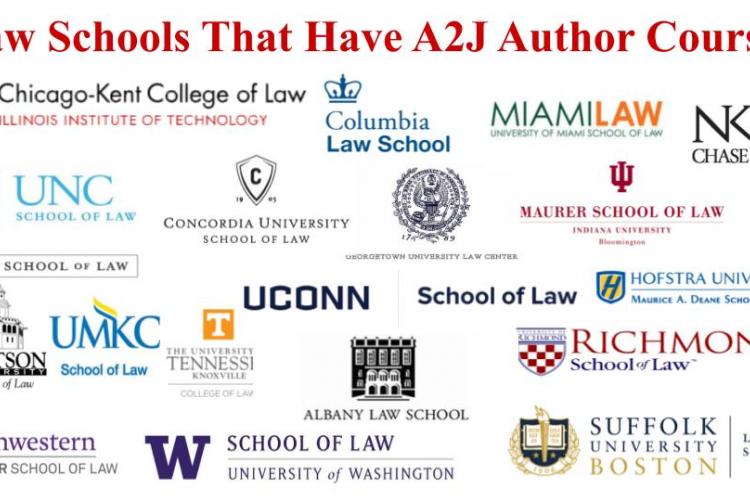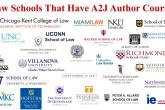A2J Author in the law school classroom
A2J Author is a great tool to use for teaching law students marketable technology skills, empathy, project management skills, and about the access to justice crisis. This page contains many of the resources CALI has prepared to help law professors teach an A2J Author course or integrate an A2J Author component into their class.

Faculty Talking About Using A2J Author in Their Classrooms
Professor Ray Brescia, Albany Law School, "Using Guided Interviews to Serve Non-Profits" at CALICon18
Also presenting: Alexandria Decatur and Julia Kosinski, two students who participated in the project and class; and Jessica Frank of CALI.
This session will describe a class project, incorporated in a course entitled "The Law of Social Entrepreneurship and Exempt Organizations," in which students utilized A2J Author to prepare two guided interviews. These guided interviews will allow end-users who may want to create a non-profit under New York Law to prepare a certificate of incorporation and by-laws for the organization in accordance with NY state law. While the students learned the substantive law of non-profits through the course, they also learned business process analysis and A2J Author programming to develop these two guided interviews. We are in the beta-testing phase through which students are presenting the interviews to community members and practicing lawyers to get their guidance and feedback before we formally launch the two interviews and make them public, which we expect to happen by the end of June 2018. This work was done with the guidance and assistance of Jessica Frank and John Mayer from CALI. The goal of the presentation will be to show the methodology by which we developed and tested the A2J Author for use in this context, but also how using A2J Author dovetails nicely with substantive/doctrinal law courses.
Professor Benjamin Barton, University of Tennessee Law, Keynote at eCourts 2018 Conference
University of Tennessee Law Professor Benjamin H. Barton expanded on the ideas in his (and co-author Stephanos Bibas) 2017 book Rebooting Justice. They argue that our laws are too complex and legal advice too expensive. Both are obstacles for the poor and even middle-class Americans to get help and protect their rights. Criminal defendants facing jail time may receive an appointed lawyer who is juggling hundreds of cases and immediately urges them to plead guilty. Civil litigants are even worse off; usually, they get no help at all navigating the maze of technical procedures and rules. The answer is to use technology and procedural innovation to simplify and change the process itself. According to the Wall Street Journal, Rebooting Justice “jump-start[s] a much-needed conversation about the future of the practice of law.”
Technical Background Required to Teach an A2J Author Course
You do not need prior technical experience beyond basic word processing to teach an A2J Author course. We provide a library of training videos (see below). We are also available to remotely present to your class with a variety of options from quick 30 minute sessions on the background of A2J Author, legal aid technology, and access to justice, to multiple session in depth trainings for your law students on the software itself. We have an extensive software manual in our A2J Authoring Guide and Sample Excersises (see below) to practice authoring skills. A2J Author is designed to be intuitive and use-friendly for end users, but also for authors, so learning the software from our resources should not take more than a few hours.
Training videos
Check out our YouTube Channel. We have over 40 videos devoted to all aspects of creating A2J Guided Interviews.
A2J Author: Legal Technology and Access to Justice: https://youtu.be/4rmnchZrirk
A2J Author sits at the intersection of legal technology and access to justice. This video explains that overlap and gives your students an introduction to the software. (Great for an introductory class in an A2J Author course or as a smaller part of a larger legal technology class)
Sample Exercises
These are a collection of sample exercises created by the A2J Author team to teach law students how to automate documents with A2J Author. Many of these exercises are expected to take an hour or less and will give the students a basic understanding of how to create document assembly projects in A2J Author, using an A2J Guided Interview and an A2J Template, or in HotDocs with a HotDocs template and an A2J Guided Interview. This is a curated list of our Sample Exercises that are generally best suited for law students learning A2J Author. For the complete list of Sample Exercises, click here.
This exercise will teach you how to automate an A2J Guided Interview and create an A2J Text Template. It uses a sample Word document that contains many of the field types you'd run into in automating an actual court form. The exercise generally takes between 60-90 minutes to complete.
This exercise will teach you how to automate an A2J Guided Interview and create an A2J PDF Template. It uses the same sample Word document as the previous exercise, but converts it to a PDF instead. The PDF contains many of the field types you'd run into in automating an actual court form. The exercise generally takes between 60-90 minutes to complete.
This exercise will teach you how to automate a complete document assembly package in under an hour. The exercise contains a simplified PDF document that is converted to an A2J PDF Template which is then automated and goes on to teach you to create the necessary questions in an A2J Guided Interview to fill out the template.
This exercise will teach you how to create a single A2J Guided Interview that can conditionally insert three separate forms/templates based on the user's answers to specific questions.
This exercise focuses on creating an A2J Guided Interview and A2J PDF Template that replicate a real world name change form.
This exercise creates an A2J Guided Interview only which focuses on scripting common logic statements found in many A2J Guided Interviews.
This exercise will teach you how to automate an A2J Guided Interview and create a HotDocs Template. It uses the same sample Word document as the first two exercises, but converts it to a PDF instead and uses another software tool called HotDocs to automate the template. The PDF contains many of the field types you'd run into in automating an actual court form. The exercise generally takes between 60-90 minutes to complete
More Sample Exercises can be found here: https://www.a2jauthor.org/content/sample-exercises-learn-a2j-author
A2J Author Course Kit
Preface by Professor Ronald Staudt:
Teaching Apps for Justice is a powerful way to deliver education needed by law students to succeed in today’s technology rich legal market while, simultaneously, improving access to justice for the poor. This A2J Course Kit is the second of three books, each a collaboration designed to expand the resources needed by law professors to teach 21stcore competencies and expand access to justice for low income people. The first publication is the Justice, Lawyering and Legal Education in the Digital Age Symposium in the Chicago-Kent Law Review, 88 Chi.-Kent L. Rev. 687, et. seq. (2013) available at https://www.kentlaw.iit.edu/institutes-centers/centerfor-access-to-justice-and-technology/2013-law-review-symposium. This Symposium, edited by Marc Lauritsen and me, contains the fully developed pedagogical theories and lessons learned by faculty who teach courses combining education in modern technology while expanding justice. The Symposium examines five courses in detail, exposing learning theories, teaching objectives and accomplishments. This Symposium is an excellent first step for a teacher seeking information and perspectives on Apps for Justice.
This A2J Clinical Course Kit is the second installment on the Apps for Justice trilogy. The book is a compendium of course descriptions, syllabi, teaching tools and recommended readings gathered from the work of 13 faculty members teaching six different courses at six different law schools. Each was selected by CALI in 2013 to participate in a two year effort to use A2J Author®, CALI’s tool for legal aid lawyers and courts, to teach law school courses targeting core competencies needed for today’s lawyers. All agreed to freely expose and share their courses and the materials in an edited collection drawn from all seven courses.
The courses are not all clinical offerings. For example, Judith Wegner at UNC teaches a Professionalism course inspired by her work on the Carnegie Commission. Her students work with North Carolina Legal Aid to build A2J Guided Interviews® for low income people. My course, Justice and Technology Practicum, is a hybrid classroom/experiential offering in which students do field work, observe court processes and build A2J Guided Interviews while meeting regularly to discuss readings and issues raised by these experiences.
We hope that you find this collection of materials, written and tested by these professors, to be a rich pedagogical treasure to be plundered for your own efforts...
Prologue:
Through the A2J Author Course Project, CALI and Chicago-Kent have exposed law
faculty across the country to A2J Author and its uses in a classroom setting. Students who are
interested in the intersection of law and technology and also have a desire to do work that
increases access to justice, can use A2J Author to create A2J Guided Interviews for use by courts
and legal aid organizations. A2J Author allows students to translate their substantive legal
knowledge into an expert system relying on rules-based artificial intelligence. Creating A2J
Guided Interviews provides students with experience working with technology and software. It
1 Jeanne Charn, Celebrating the “Null” Finding: Evidence Based Strategies for Imporving Access to Legal Services, 122 YALE L.J. 2206 (2013). 2 Id.
introduces students without a technical background to the type of logical reasoning used in
programming. Students are using A2J Author to transform a standard legal form required by a
court, and its underlying law, into a series of questions for the self-represented individual to
complete. Through courses including A2J Author, students have been able to develop critical
lawyering skills. They learn client-focused skills like counseling and plain language
communication as they think through how questions will be asked, displayed, and sequenced
across the pages within an A2J Guided Interview. . .
Sample Syllabi
-
Traditional clinics: http://a2jauthorcoursekitbook.lawbooks.cali.org/chapter/traditional-clinic-syllabi/
-
Professionalism courses: http://a2jauthorcoursekitbook.lawbooks.cali.org/chapter/professionalism-course-syllabi/
-
Hybrid Legal Practicums/Seminars: http://a2jauthorcoursekitbook.lawbooks.cali.org/chapter/hybrid-legal-practicumsseminar-syllabi/
Suggested Readings
- Justice, Lawyering and Legal Education in the Digital Age Symposium in the Chicago-Kent Law Review, 88 Chi.-Kent L. Rev. 687, et. seq. (2013) available at https://www.kentlaw.iit.edu/institutes-centers/centerfor-access-to-justice-and-technology/2013-law-review-symposium.
- Jessica Frank, A2J Author, Legal Aid Organizations, and Courts: Bridging the Civil Justice Gap Using Document Assembly (May 2017). Western New England Law Review, Vol. 39, No. 2, 2017. Available at SSRN: https://ssrn.com/abstract=3050065
- Jeanne Charn, Celebrating the “Null” Finding: Evidence Based Strategies for Imporving Access to Legal Services, 122 YALE L.J. 2206 (2013)
- The Justice Gap: Measuring the Unmet Civil Legal Needs of Low-Income Americans, Legal Services Corporation (June 2017), https://www.lsc.gov/sites/default/files/images/TheJusticeGap-ExecutiveSummary.pdf.
- Rochelle Klempner, The Case for Court-Based Document Assembly Programs: A Review of the New York State Court System’s “DIY” Form 1191, 41 Fordham Urb. L.J. (2014).
- Richard S. Granat & Stephanie Kimbro, The Teaching of Law Practice Management and Technology in Law Schools, 88 CHI.-KENT L. REV. 757 (2013).
- Daniel Martin Katz, The MIT School of Law? A Perspective on Legal Education in the 21st Century, 2014 Illinois L. Rev. 1431 (2014), http://papers.ssrn.com/sol3/papers.cfm?abstract_id=2513397.
Presentations About A2J Author
- https://www.youtube.com/watch?v=6suw8Cuatxg&t=33s: Chicago-Kent law student Hanna Kaufman spoke at the White House Forum on Increasing Access to Justice on April 14, 2015. She presented on her experience in the Justice and Technology Practicum taught by Professor Ron Staudt. She spoke about creating an A2J Guided Interview and document assembly package for the California Administrative Offices of the Court and her subsequent work on three A2J Guided Interviews for Kansas Legal Services.
- https://www.youtube.com/watch?v=yvsPuLjQrkE&t=296s: John Mayer gives the keynote at SEAALL 2019 on Saturday, March 23, 2019. Law Librarians and Access to Justice: A Golden Opportunity
- https://www.youtube.com/watch?v=UIu3-1FTIjg: Susan Ingles from South Carolina Legal Services was a guest speaker on our August 2019 A2J Author New User Webinar. Susan is the Consumer Law Unit Head and Senior Staff Attorney at South Carolina Legal Services. She talked about how her team implemented 5 online classrooms for self-represented litigants using another CALI support tool called Learnthelaw.org. Susan's team worked with private attorneys, the judiciary, the South Carolina state bar association, law students, and others to build out the online classrooms. These online classrooms walk self represented litigants through the process of a debt collection defense, getting their landlord to make repairs, unemployment benefits appeals, guardianship, and filing an order of protection. They include instructions, videos, guidance, and A2J Guided Interviews for filling out the necessary paperwork.


